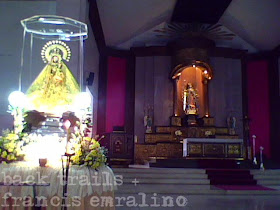The image of the Nuestra Señora de Guadalupe is a common sight already on some parts of Laguna. Its images were once included in the promotional posters of the town of Pagsanjan, together with Pagsanjan Falls, found at the rear side of buses. But the visit to the church where the statue is actually found is more informative than just seeing it on posters.The church is beautifully situated, much like the church in Calauan, Laguna – close to the mountains and the wide expanse of fields. (As I continue traveling to towns once administered by the Spaniards, I cannot help but be amazed by their keenness in placing their places of worship.)
The very first church in town was built in 1687. Its first curate was Father Agustin de la Magdalena. In 1690, reconstructions [was the original one destroyed?] of the church – a chapel actually – were made using bamboo and nipa [were they also constructed through force labor like in other places?]. The reconstructions were made under the direction Miguel Guan-co and Alguacil Mayor Alfonso Garcia. Further improvement was done by Father Joaquin de Coria in 1853. And in 1872, the church’s transept was constructed led by Fathers Serafin Linares and Cipriano Bac. And just like in many other churches in Laguna, it was destroyed during the Second World War.
 * close up of the altar with its reredos
* close up of the altar with its reredos  * graves within the capilla
* graves within the capilla * Trailer Pransis posing grimly inside the capilla
* Trailer Pransis posing grimly inside the capillaCapilla del Tilma
Anyone who plans to visit the church should not miss to enter Capilla del Tilma, a side chapel with graves on its very walls. These graves give ys an idea of the social status of those buried there. They must have been from rich families to afford places inside the chapel.
We can always talk about the dead and death, but it is a different story to be amongst the dead, literally. When we entered the capilla, the atmosphere was stifling, with no place for fresh air to come in. There were several grilled windows, but it was not enough to let breeze come in and take away the ambience. Again I was reminded of the seeming barrenness of death, if one’s death is of no significance at all. We always hear of the saying: “we only have one life and so we must make the most out of it.” I say we can only have one literal death, and so let us make it worthwhile; like dying for something worth dying for. Anyway, enough of this death talk.

* the municipal building of Pagsanjan; too bad I forgot to note the marker visible in this photo; the building must have been an old one
 * our beloved Jose Rizal given a semi-elaborate place in the town’s mini-plaza
* our beloved Jose Rizal given a semi-elaborate place in the town’s mini-plaza
 * a monument for the war veterans of the town, made less significant by its neglect and the younger generation’s vandalism of the monument
* a monument for the war veterans of the town, made less significant by its neglect and the younger generation’s vandalism of the monument
 * our beloved Jose Rizal given a semi-elaborate place in the town’s mini-plaza
* our beloved Jose Rizal given a semi-elaborate place in the town’s mini-plaza * a monument for the war veterans of the town, made less significant by its neglect and the younger generation’s vandalism of the monument
* a monument for the war veterans of the town, made less significant by its neglect and the younger generation’s vandalism of the monumentThe view outside is a pleasant one, with two main streets decked by big houses on their sides. I remember visiting Pagsanjan during my high school days. The place is called Anibong. But I cannot recall how to get there.
I shall be sharing next one of finest finds in town: its houses!





No comments:
Post a Comment